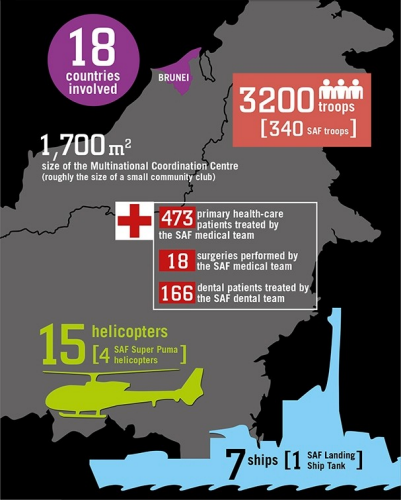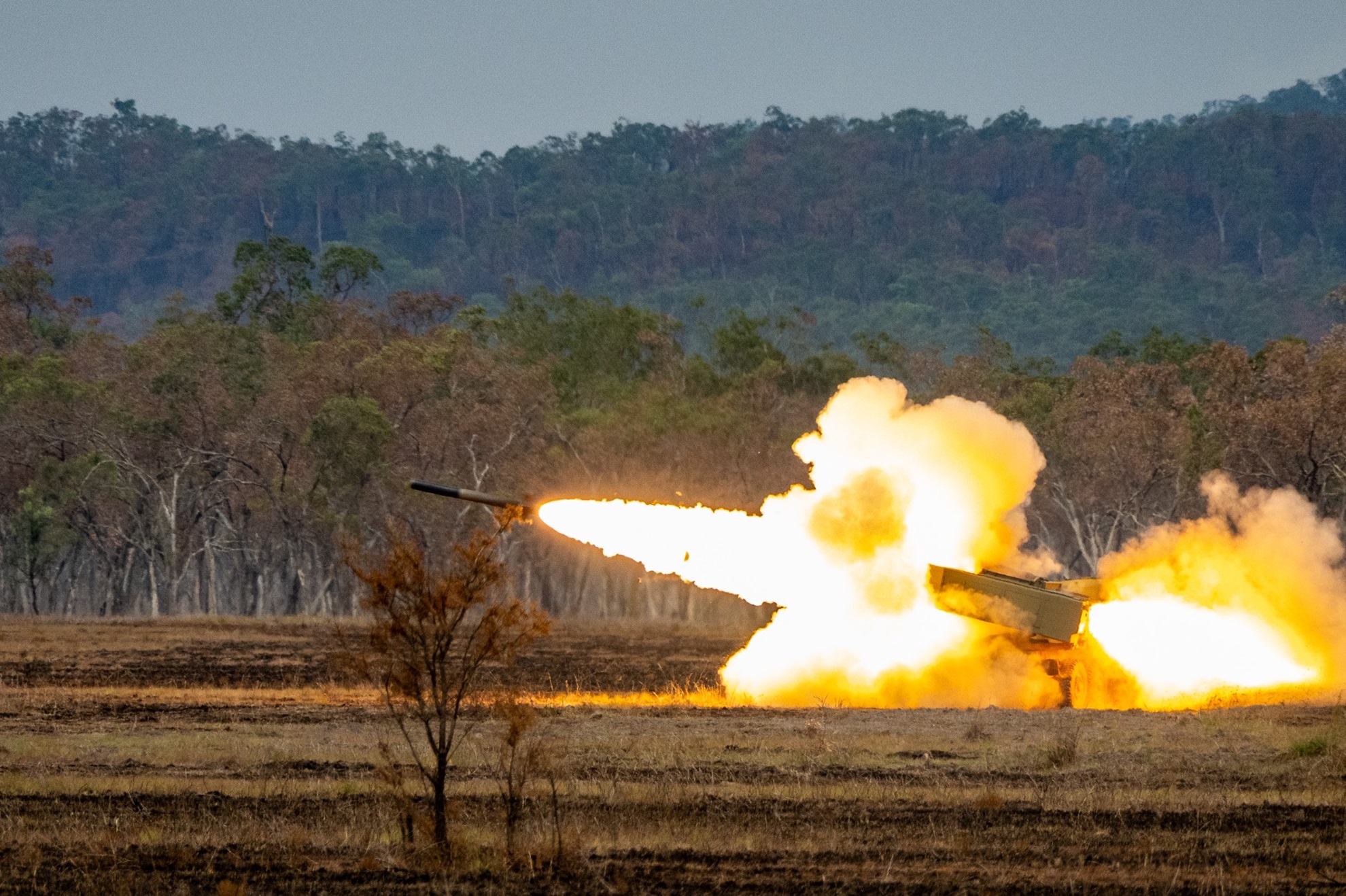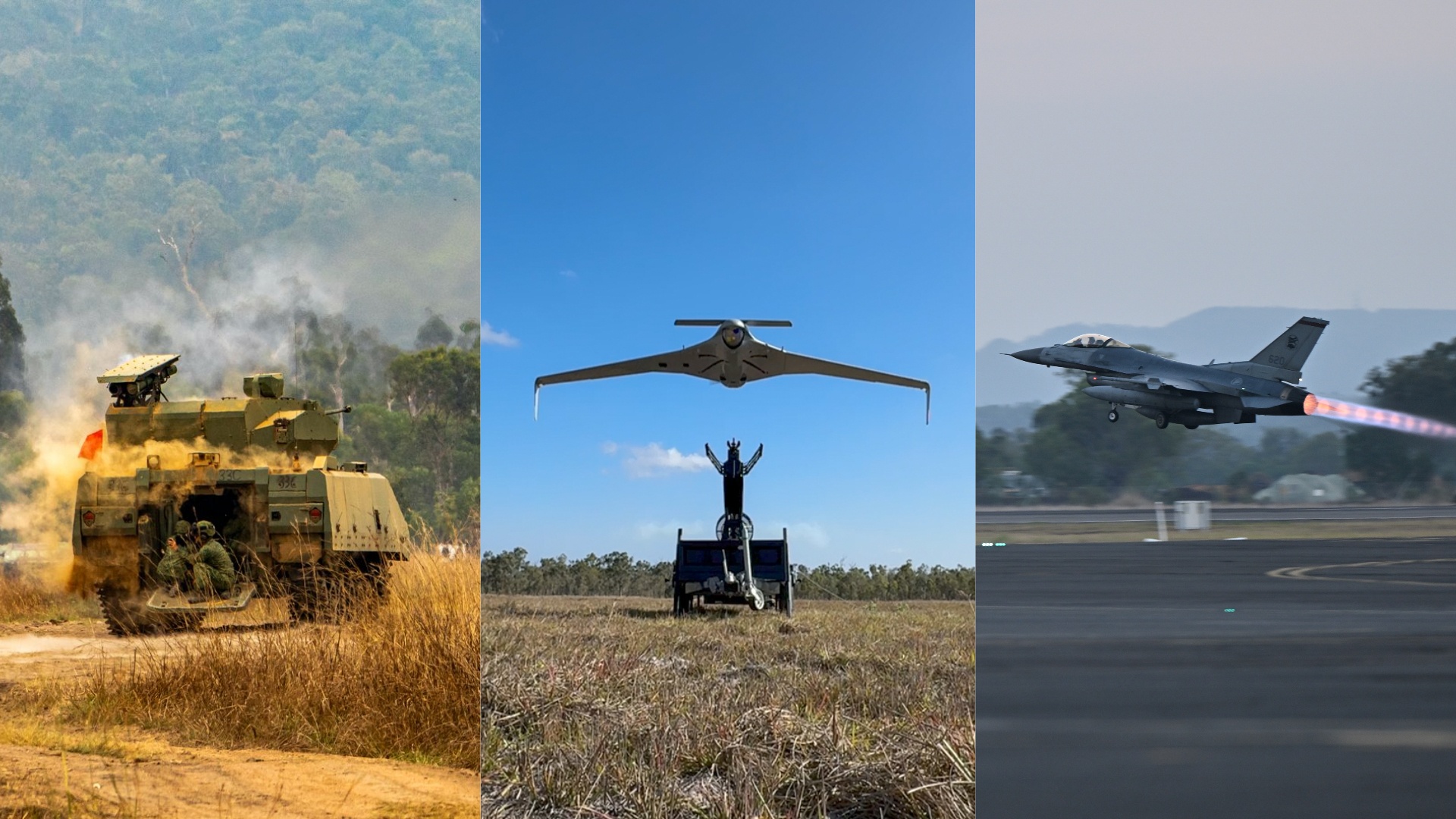OPS & TRAINING
PREP FOR DISASTER
14 Aug 2013

PIONEER brings you the action that took place when 18 countries gathered for a disaster relief exercise.
"Tolong ("help" in Malay)! People dying! Help us!" Sprawled on the rubble-strewn ground, a young man waves his hands in hysteria, trying to get help as he cries out "sakit, sakit!" ("pain, pain!" in Malay). His white T-shirt is stained scarlet by blood seeping from an open wound to the left side of his head. His right leg is a mangled mess, with a fragment of his shin bone protruding through his skin.
A few feet away, badly battered cars lie under broken planks and cement slabs. Metres from that, a hand covered in ash sticks out from a pile of fallen debris. This is Mentiri, a town where several houses have collapsed due to soil erosion.
This scene of devastation was a test site for troops from 18 countries to practise their responses to disasters.
Large-scale exercise
This was part of the ASEAN Defence Ministers' Meeting (ADMM)-Plus Humanitarian Assistance and Disaster Relief (HADR) and Military Medicine (MM) Exercise, which took place in Brunei from 17 to 20 Jun. It involved the 10 ASEAN countries, and the "Plus" countries Australia, China, India, Japan, Republic of Korea, New Zealand, Russia and the United States (US).
About 3,200 troops, seven ships and 15 helicopters from the 18 countries took part in the exercise, which required participants to respond to two disasters that followed a massive typhoon. Flash floods caused by torrential rain in Kampong Biang damaged a bridge across the Biang River, leaving 100 dead and 300 stranded. Soil erosion in Mentiri caused houses to collapse, injuring 30 and displacing 1,000.
Over the four days, military forces carried out search and rescue missions, built bridges to reach flood-stricken villagers, purified water for victims, distributed necessities and treated casualties.
Coming together
The Singapore Armed Forces' (SAF's) then-Director of Joint Operations Brigadier-General (BG) Ngien Hoon Ping explained why this exercise was important: "An exercise like this provides a very useful and safe setting where militaries can come together and promote confidence, peace and stability.
"It shows that the ADMM and ADMM-Plus track is a very feasible and practical one. It's not just about discussions, concepts and policies - you can see practical cooperation here on the ground in Brunei."
The exercise was also a platform for members of the Experts' Working Group on Military Medicine (EWG-MM) to apply what they had been planning since the group's formation in 2011 after the first ADMM-Plus Meeting in October 2010. The EWG-MM looks at medical support operations, especially in the context of disaster responses, and aims to improve operations among the medical services in the ADMM-Plus militaries.
According to Chief of the SAF Medical Corps Rear-Admiral (then COL) (Dr) Kang Wee Lee, who is one of two co-chairs of the EWG-MM, the group has met for several workshops and table-top exercises since it was formed. "This field training exercise is a good platform for us to exercise and to validate the SOPs (Standard Operating Procedures) which all member countries have developed as part of the EWG-MM framework."
The SOPs includes a Needs Assessment Template for countries assisting the host country to find out the needs of the host country, and a Reporting Template that allows assisting countries to provide updates on what they have done.
Months of planning
An exercise of this scale required much planning by member countries, said Chief Guards Officer BG (then COL) Desmond Tan. He was one of five Chiefs of Staff at the Multinational Coordination Centre (MNCC), a command and control centre for the exercise.
He explained: "Ensuring that all the countries were able to transport their assets on time and seamlessly was a big logistical challenge, and credit goes to the host nation Brunei for being able to manage this... Also, as this exercise taps on the expertise of the different countries, it was challenging trying to design it such that everybody can contribute meaningfully.
"Months of planning and hard work by the 18 countries, which were determined to make this exercise happen, helped to make sure that we were able to execute the exercise."
From drills to actual help
The SAF took part in this exercise with 340 troops, one Landing Ship Tank (LST), four Super Puma helicopters, as well as medical and combat engineer assets. The LST transported land assets to Brunei, while the helicopters evacuated casualties during the exercise.
The medical team, which operated a primary health and surgical facility to attend to casualties for the exercise, also extended medical services to the locals in Bangar and Selangan towns. The team treated patients with conditions such as the cold and common injuries, provided dental treatment, and performed surgeries such as cyst removal.
Commanding Officer of the 3rd Combat Support Hospital Major (NS) (Dr) David Ng, whose unit was in charge of running the medical facility, considered the exercise an enriching experience for his team: "This was an opportunity for my unit to put into real operation the concepts and drills that we've been training for."
Dental Assistant at the Headquarters Military Medicine Institute Lance Corporal Chee Yung Seng added: "Learning from other dental teams gave me the chance to improve my skills and find out other methods of treating dental patients."
Working well together
Together with the Royal Brunei Armed Forces (RBAF), the SAF combat engineers built a modular kit 11.3m long, 5.4m wide and 3.1m high. Looking like a room the size of a container cabin, it was used as a medical post during the exercise. After the exercise, the kit was given to a primary school in Selangan to be used as a classroom.
1st Sergeant (1SG) Pradeep s/o Karipahyah, a section commander in the Headquarters Army Combat Engineers Group, spoke about his experience building the kit: "I learnt a lot from working with the Bruneians - their language, their culture, the way they work. Plus, the children here are happy to see us. They're always smiling at us, saying hello and shaking our hands. So we're really happy to be here to do this."
Private Rozaserdi Abdul Rasak, a combat engineer from the RBAF, said: "It's been interesting and fun working with the Singapore engineers. Although their working styles are different from us, we could still interact very well."
Asked what he thought of the SAF engineers, he replied: "Bagus la (Malay for 'good'), they are very professional, and they always think safety-first."
Useful lessons
For participants, besides levelling up their skills during the exercise, many also benefited from interactions with other militaries. Said BG Tan after the exercise came to an end: "As a professional military, (our SAF troops) have learnt from many countries who have a lot of experiences in humanitarian assistance missions. This was a very practical and professional exercise that allowed us to exchange our views and practices, and get to know people from other militaries better."
Colonel (U) Haji Hamzah bin Haji Sahat from the RBAF, who was Commander of the MNCC, agreed: "There were many useful lessons learnt, and I'm very happy with the outcome of the exercise."
He added: "There's no doubt that the Singapore officers are very professional. Our cooperation with the Singapore Armed Forces, especially in organising this exercise with them, has been very satisfying."
Numbers at a glance
ALSO READ IN OPS & TRAINING

Exercise Wallaby 2025: To see better, shoot faster
31 Oct 2025
The SAF focuses on complex strike missions and multi-domain integration in Exercise Wallaby 2025, the 35th edition of its largest unilateral overseas exercise.

Ex Wallaby 25 – Greater Integration and Complexity
25 Oct 2025
The 35th edition of the SAF’s largest unilateral overseas exercise is an opportunity for expanded scale and deeper integration towards an effective, networked fighting force.

Ex Forging Sabre ramps up use of unmanned assets in integrated strike operations
12 Sep 2025
In this 10th edition of Exercise Forging Sabre, the SAF sharpened its cutting edge for the dynamic modern battlefield, with expanded integration between manned and unmanned platforms.



